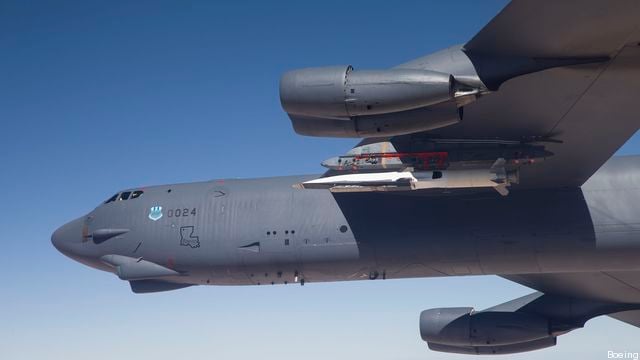
A B-52 prepares to launch the X-51 “hypersonic” test vehicle.
WASHINGTON: “I believe, today, we could build a Mach 5 cruise missile [with] off-the-shelf materials,” said Charles Brink of the Air Force Research Laboratory. “We could go 500 nautical miles in 10 minutes.”
Brink should know: He ran AFRL’s record-breaking X-51 program. Now AFRL and the Defense Advanced Research Projects Agency (DARPA) are co-funding a pair of follow-on projects: one for a hypersonic jet like the X-51, aspiring for Mach 8, and another for a different high-speed technology called “boost-glide.” Brink told a recent meeting of the Royal Aeronautical Society’s DC chapter that “those will probably both fly in 2018-2020.” The US Army also has a hypersonics program, and China is testing hypersonic missiles of its own.
Why bother? Ballistic missiles have been going at comparable speeds since Werner von Braun invented the V-2 some 70 years ago. The difference is that V-2s, Scuds, Minutemen, and so on follow a ballistic arc up out through space, while hypersonic systems like the X-51 fly at five or more times the speed of sound in the atmosphere.
Skeptics argue that pushing through all that air resistance just makes the engineering problem needlessly difficult. Believers like Brink and Breaking Defense contributor Robbin Laird argue hypersonics makes a major military difference. The value isn’t speed alone, they say, but a combination of speed, flexibility, and surprise.
First of all, a hypersonic cruise missile would be much smaller then a ballistic missile. Hypersonic engines, like other jet engines, are “air-breathing,” meaning they burn their fuel by mixing it with oxygen from the atmosphere. Ballistic missiles and satellites launch on rocket boosters that must carry their own oxidizer with them. On the recently retired Space Shuttle, for example, the largest tank was mostly carrying oxygen. Smaller missiles can launch from a wider variety of smaller platforms — ships, ground vehicles, even aircraft — giving US commanders more options and the enemy more potential threats to track.
Second, a ballistic missile launch is so bright and hot that you can see it from space: The US has an entire network of satellites to do just that. Once that booster cuts off, the warhead and its “reentry vehicle” coast, cold and dark, against the background of space, but they can’t change course: They’re stuck following a ballistic curve (hence “ballistic missile”) which is so predictable that Sir Isaac Newton could calculate where the target has to be. The X-51 also requires a rocket boost, but a much smaller one, enough to reach Mach 4.8 rather than to exit the atmosphere. Then, once the X-51’s scramjet engine kicks in, it burns much less intensely but continuously, providing thrust throughout the flight. So a hypersonic missile would much less detectable and much more maneuverable than a ballistic one.
As a result, said Laird, a hypersonic missile could have “a very complicated launch trajectory which goes very fast into the target, which basically makes it unstoppable.”
“The faster you fly, the more difficulty [enemy systems] have in tracking you, in hitting you,” Brink told me after his public remarks. Even if long-range early warning radars see you coming — which is far from certain, since hypersonics require such a highly streamlined design even the X-51 demonstrator was “inherently somewhat stealthy,” he said — the enemy has much less time to analyze the data, confirm you’re a threat, and transfer the targeting data to short-ranged but higher-precision radars used by interceptor aircraft and anti-aircraft missiles.
“The handoff between those systems and the update of those systems are made much more complex if you’re coming at them at Mach 5 rather than Mach 0.8,” Brinks said. While a Mach 5 hypersonic missile covers 500 nautical miles in 10 minutes, he said, “right now, a conventional cruise missile would take 45 minutes to an hour.”
In the vastness of the Asia-Pacific theater, however, 500 miles is relatively short-ranged: Even a Mach 5 missile would take almost an hour to get from, for example, the US bases on Okinawa to the Chinese space facilities in Xinjiang.
“Mach 5 doesn’t buy you anything,” said Robert Stein, a member of the Pentagon’s Defense Science Board. “If you really want to get up into a regime where its really helping, double that number. Now you’re starting to talk” — and really starting to get into some difficult engineering. “There are niche roles [for hypersonics],” he told me after a recent missile defense conference, “and one can argue whether the niches are really worth the difficulty.”
“There’s nothing magic about Mach 5,” Brink himself told me. “Why not four or seven? We are all looking at all of those,” he said. The Air Force is studying high-speed turbines going Mach 2.5, ramjets going Mach 3 to 4, and boost-glide systems reaching Mach 8 to 10, as well as hypersonic “scramjets” like the X-51.
“There are other capabilities that could get us faster missiles sooner [than hypersonics],” Laird told me. “I think we need to look at missiles across the board.” After committing hundreds of billions to the F-22 and F-35, often called fifth generation jet fighters, he said, “we’re flying fifth generation aircraft with third and fourth generation weapons.” Hypersonics could be one way for the weapons to catch up to the planes that carry them.
“It’s not the Manhattan Project,” Laird said. “I would make a moderate, steady investment” — preferably in partnership with the Australians, who have a hypersonics project of their own — “and see how the technology matures.”
Air Force’s legislative proposal is an existential threat to the National Guard
In this op-ed, Francis M. McGinn, the head of the National Guard Association, blasts an Air Force proposal to transfer National Guard units performing space missions to the Space Force.


























